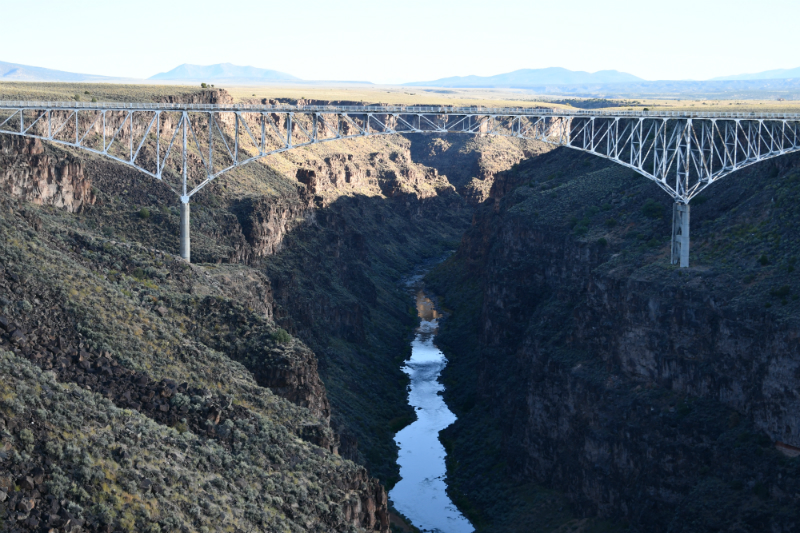Taos, N.M., sits in the foothills of the Sangre de Cristo Mountains and is within easy driving distance of Santa Fe. While indigenous people have lived outside of Taos for over 1,000 years, few settlers called Taos home until the Taos Society of Artists was established in 1915, just three years after New Mexico achieved statehood. The town’s natural surroundings continue to attract artists to this day. Similar to nearby Santa Fe, art stores and small museums are ubiquitous in Taos. And winter tourism increased in the 1950s with the opening of Taos Ski Valley.
A few Jewish immigrants found their way to Taos. And in the 19th and 20th centuries, some started their American business careers in other New Mexico towns and subsequently added businesses in Taos.
Alexander Gusdorf and his half-brother Gerson, for example, owned a number of notable Taos businesses, including a general store and the Don Fernando Hotel, which promoted the work of the Taos Society of Artists until the structure burned down. Alexander Gusdorf was the founder and president of the First State Bank of Taos. After his death in 1923, his wife, Bertha Gusdorf, became one of the first female bank presidents in New Mexico.
At the Taos Jewish Center, Jews from diverse backgrounds come together in a rented storefront space. Lay leadership fuels the day-to-day running of the community, and Rabbi Judith HaLevy, the former rabbi of the Malibu Jewish Center and Synagogue, is their part-time rabbi.
For Rabbi HaLevy, “Spiritual places offer an important dimension to the Jewish experience. While they often attract Jews running away from Judaism, these places frequently reawaken core elements of Judaism lying dormant for years.”
She shared the community’s practice of gathering near the Rio Grande Gorge Bridge, located 13 kilometres northwest of Taos, on the second day of Rosh Hashanah.
Community support led to the establishment of New Mexico’s only free-standing Jewish cemetery. On the outskirts of Taos, local Jews find their final resting place in an open field with spectacular views of the surrounding countryside.
Chabad has had a presence in Taos since 2008. With a brother in Albuquerque, Rabbi Eli Kaminetzky, a former New Yorker, can remain connected to family while living far removed from his traditional Orthodox community. With his spiritual priority focused on reaching out to his community, he actively engages with Jews within an hour’s drive of the local Chabad House.
READ: DISCOVERING EARLY JEWISH HISTORY IN CHARLESTON
While in Taos, we explored the Native American culture and became acquainted with local history by visiting the Taos Art Museum at Fechin House and the Couse-Sharpe Historic Site. At the Taos Pueblo, local Native-American college students volunteer their time to introduce visitors to their history and culture.
Their history includes confrontations with nomadic Native American tribes, the Spanish and the United States Army. A guided walking tour through the pueblo reveals centuries-old traditions handed down from generation to generation.
A tribal government oversees more than 48,500 hectares of land surrounding this indigenous community. These culturally resilient people were the first tribe to successfully petition the U.S. government to have their homeland returned. Former president Richard Nixon returned the Blue Lake region to the Puebloan people in 1970.
For lunch, we dined at El Gamal. Elad Greenvald, an Israeli, came to Taos with a friend about 20 years ago and then returned with his wife in 2008. For more than a decade, Greenvald has considered Taos his home.
El Gamal is the only vegetarian restaurant in downtown Taos. The dishes were inspired by Greenvald’s family recipes. His maternal grandparents were Chicago Zionists who made aliyah in the 1950s, and his paternal grandparents were eastern European Jews who also made Israel their home. El Gamal’s falafel was on par with the falafel we’ve tasted in Israel.
Winter ski enthusiasts may be intrigued by the Jewish connection to the nearby Taos Ski Valley resort. Ernie Blake (born Ernst Hermann Bloch), a German Jew who was raised in Switzerland and later immigrated to the United States, was the owner and founder of the ski resort. As a second lieutenant in the United States Army, he used his native German language skills to interrogate approximately 200 German prisoners, including infamous Nazis such as Hermann Goering and Albert Speer, during and after the Second World War.
He learned about New Mexico from one of his relatives, Salomon Spiegelberg. Blake discovered the site where he started Taos Ski Valley while flying his own plane over northern New Mexico. He, along with his wife, Rhoda Limburg Blake, opened the mountain for skiers in 1955. Four of the ski runs – Stauffenberg, Oster, Tresckow and Fabian – were named after the German officers who tried to assassinate Hitler in 1944. The Blake family sold the ski resort in 2013.
At the Rio Grande Gorge Bridge National Monument, we followed the path running along the 250-metre gorge, revealing layers of volcanic basalt flows and ash. In 2013, the Obama administration established the Rio Grande del Norte National Monument with 97,000 hectares of protected land adjacent to the Rio Grande near Taos. Several trails in varying lengths and difficulty are available to hikers.
While taking pictures of the surrounding landscape and the seventh-highest bridge in the United States, we could appreciate Rabbi HaLevy’s spiritual connection to this national monument.
The Waite Company arranged the complimentary stay at the Historic Inn of Taos and provided complimentary tickets to local attractions. The New Mexico Jewish Historical Society offered invaluable assistance in locating Jewish resources.
